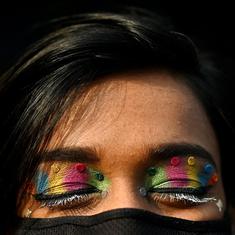He explained, “Think of what can happen if a woman is taken as a prisoner in combat operation."
The induction of women into the army has not been an easy process. Until 1992, women in the Indian armed forces were limited to Army Medical Corps, the Army Dental Corps and the Military Nursing services. Once the doors opened, the armed forces began recruiting women as short-service commissioned officers, which allowed them to serve for between five years and 14 years.
It started out with an experimental batch of 25 women. Anajana Bhaduria, the gold medalist in that first group, went on to serve in the army for 10 years.
It was only after 2011, that women were permitted to become permanent officers in two branches in the forces: education and law. But the next year, the Defense Ministry decided to ban women from combat operations, taking took into consideration the recommendations made by the Integrated Defence Staff headquarters in 2006 and the Tri-Services Committee in 2011.
Republic Day spectacle
You wouldn’t have known this if you watched this year’s Republic Day ceremony in Delhi. For the first time, an all-woman contingent of 148 personnel from the army, navy and air force marched down Rajpath. (The cheering spectators included the chief guest, US President Barack Obama, who flashed the women a thumbs up sign of approval.) In addition, Squadron Leader Sneha Shekhawat of Sikar Rajasthan, lead the all-women Indian Air Force march. Also in the parade was Captain Urvashi Rana commanding a T-90 Bhishma tank.
But though the parade highlighted the presence of women in the armed forces, it failed to question was the actual involvement of women in the armed forces.
By claiming that women cannot participate in combat operations due to safety concerns, the Defence Minister’s statement has made two truths obvious. The first is though the armed forces claim to empower women, it’s clear that they have a long way to go. Even though the minister has said women will be able join “other operational forces”, it is still not clearly evident, what those roles would be and what time span this involves. It is also obvious that the armed forces still treat women as the weaker sex. Parrikar’s statements reinforce the idea that the armed forces are still male dominated and reflect the patronising mindset India has towards its women citizens.
Extreme test
Combat operations are not easy – not even for men. They test an individual’s physical endurance capabilities. That is why applicants are put through rigorous physical, emotional and mental tests before they can be selected for the armed forces. Most men don’t get through. But to generalise and assume that women won’t be able to meet these standards is not the fair. They deserve a chance to participate. Besides, any individual in a combat operation knows full well what the possible consequences could be. Assuming that the fate of a woman is worse than that of a man merely reinforces gender stereotypes that rest on the patriarchal notion that national honour is contained in the bodies of India’s women.
With Parrikar’s clarification, India has failed to acknowledge that many countries across the world have opened combat operations for women. According to a 2010 survey by the British Ministry of Defence, Canada, Denmark, Finland, France, Germany, Israel, the Netherlands, Norway, Poland, Romania and Sweden permit women in close combat roles. Australia, Ehtiopia, Pakistan, Japan, Israel, Eretria, Bolivia and South Africa have also allowed women a degree of involvement in combat operations.
Indian women have never obtained their rights without a struggle. As they battle inequality and prejudice, they should also fight for their right to fight for their country.










